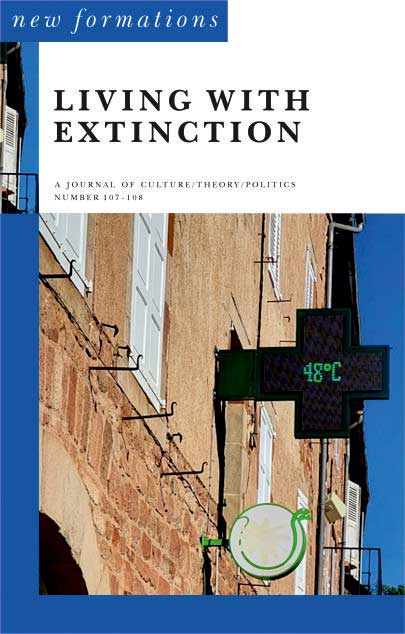
Nuclear Weapons and Extinction as Progress
New Formations - Print ISSN 0950-2378 - Online ISSN 1741-0789
Volume 2022 Number 107 & 108
Nuclear Weapons and Extinction as Progress
Michael Gardiner pages 66‑83
DOI: 10.3898/NewF:107-8.04.2022
Abstract
Nuclear weapons have delivered more near-extinction encounters than any other anthropogenic threat, but for the three decades after the Cold War discussion of this threat was relatively sidelined. This paper points to some of the historical connections between ‘war-ending’ weapons, deterrence logic and its breakdown, and the binding between the sublimation of politics into commerce and an extinction logic held within it. It firstly gestures towards roots in the ideal of market mediation as civilisation rising in the eighteenth century; secondly it looks at some writing on the conception of nuclear weapons and the surprisingly long history of awareness of anthropogenic extinction risk this brings; thirdly it suggests that a post-Cold War revival of the binding of market realism to progress that had led to the ‘weapon to end war’, and the condition of deterrence, helps explain the fall in discussions of nuclear extinction; and fourthly it notes that current proliferation and destabilisation question this deep and largely unspoken conventional wisdom over nuclear ‘non-violence’. It points to various moments in the imagination and realisation of viable nuclear weapons and their embedding in democratic regimes in Atlantic powers in particular, and to points of serious scientific consideration of extinction during the Cold War, and suggests that the long naturalisation of nuclear weapons has taught us to ‘live extinction’ in a way that speaks to other anthropogenic risks. Climate and nuclear crises indeed can be read as nodes on a trajectory of extraction and exchange defining a narrow conception of progress that has extinction as its telos. Ideas of ‘total’ deterrence become widespread during the imperial rivalries following this extractive-productive ethics, and take nuclear form as early as the first decades of the twentieth century. After ‘stable’ deterrence, though, as nuclear arsenals remained to back the Anglo-American ‘victory’ in the Cold War, these arsenals reached the apotheosis of their long depoliticising, dehumanising mission, standing as a silent horizon absorbing conflict and helping to explain a lack of political ‘newness’ often felt during late neoliberalism. With the more recent complex and largely obscured re-arming, nuclear weapons are being rediscovered as both an existential threat and an imperative to rethink the scope of political action.
SORRY - you are not registered as being permitted online access to the full text of this article
You have the following options:
- If you are viewing this via an institution or academic library you can ask that your institution takes out a Subscription to this journal.
- If you already have a Personal Subscription please login below
Forgotten your username / password? Click here to locate
- Purchase an annual Personal Subscription
PRINT + DIGITAL personal subscription (£45 / year)
DIGITAL personal subscription (£30 / year)
A Personal Subscription provides immediate access not only to the single article you are seeking, but also to all past and future articles in this journal up to the expiry of your annual (calendar year) subscription. - Purchase immediate access to this single article (UK£7.00) - Buy article Coming Soon
To cite this article
Michael Gardiner (2022) Nuclear Weapons and Extinction as Progress, New Formations, 2022(107 & 108 ), 66-83 . https://doi.org/10.3898/NewF:107-8.04.2022
